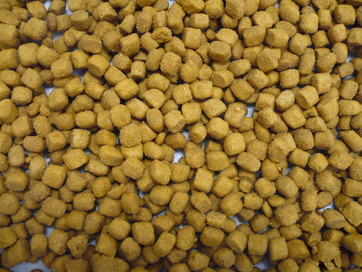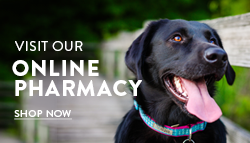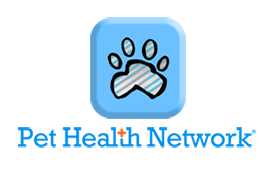The Dark Side Of Delicious

That yummy chocolate chip cookie. The extra piece of pizza. We've all been there. It's easy to forget that it is just as easy for our pets to gain a few extra pounds as it is for us humans. Whether we grudgingly admit it, or possibly even if we are in denial, sometimes there just is no way around a diet. Our pets don't care if they can still fit into that old pair of jeans, so why lose weight? Take it from us, every day we see weight related problems such as diabetes, aggravated hip displasia, blown out knees, heart disease, and other very serious (and expensive) problems. Living within healthy weight boundaries really is worth it! Don't do it alone... let our Staff be your weight loss support team!
Obesity and Weight Loss
It is important to have a realistic plan, and to make sure everyone in your family is consistently adhering to the plan. It is critical that overweight felines do not lose weight too quickly, or they could develop hepatic lipidosis, a life-threatening condition. We can assist you with the weight loss process by offering your pet a free weight evaluation, a target ideal weight, and feeding recommendations to help you achieve your pet's goal. If not already on a light formula/weight management formula, your pet should be transitioned to a light diet (make food changes gradually). Remember that excessive treats, table scraps, and ingestible toys such as rawhides (made of dried fat) can undermine any weight loss efforts. There is no charge to use our scale, sobring your pet into the clinic anytime to check the weight so we can monitor your progress. Keep in mind that certain medical problems such as thyroid disease or other issues may affect a pets weight, so some basic screening may be a good idea prior to a diet.
Serving Sizes
Just as with humans, a predetermined serving size is critical in knowing how many calories a pet is taking in. Simply pouring food in the bowl right out of the bag is a sure way to overfeed.
1.) Start with a recommended ideal weight for your pet
2.) Determine how much food to feed based on the calorie content of your pet's food and your doctor's recommendation for many calories your pet should be ingesting.
3.) Use a measuring cup to measure the food out precisely.
If you have multiple pets, be sure to feed them from separate dishes so each individual pet's food intake can be monitored. Lifestage considerations are also important. In general, puppies and kittens should receive a growth formula until they are spayed or neutered; adult pets should be fed an adult formula up to the age of 7 years old; after that point, pets should be fed a senior formula. Lifestage formulas should be tailored to your individual situation depending upon your pet's breed, age, activity level, and lifestyle. Feeding for the proper lifestage will help to ensure the proper amounts of proteins, fats, vitamins and minerals are being fed. Overly rich diets for a particular lifestage may result in kidney problems, obesity, diabetes, heart disease, osteoarthritis and joint diseases, and other preventable problems.
Questions? Need additional support? A shoulder to cry on?
We are here for you, so don't be shy... Contact Us at 651-452-5156 and we can sensitively discuss this tricky topic.
Obesity and Weight Loss
It is important to have a realistic plan, and to make sure everyone in your family is consistently adhering to the plan. It is critical that overweight felines do not lose weight too quickly, or they could develop hepatic lipidosis, a life-threatening condition. We can assist you with the weight loss process by offering your pet a free weight evaluation, a target ideal weight, and feeding recommendations to help you achieve your pet's goal. If not already on a light formula/weight management formula, your pet should be transitioned to a light diet (make food changes gradually). Remember that excessive treats, table scraps, and ingestible toys such as rawhides (made of dried fat) can undermine any weight loss efforts. There is no charge to use our scale, sobring your pet into the clinic anytime to check the weight so we can monitor your progress. Keep in mind that certain medical problems such as thyroid disease or other issues may affect a pets weight, so some basic screening may be a good idea prior to a diet.
Serving Sizes
Just as with humans, a predetermined serving size is critical in knowing how many calories a pet is taking in. Simply pouring food in the bowl right out of the bag is a sure way to overfeed.
1.) Start with a recommended ideal weight for your pet
2.) Determine how much food to feed based on the calorie content of your pet's food and your doctor's recommendation for many calories your pet should be ingesting.
3.) Use a measuring cup to measure the food out precisely.
If you have multiple pets, be sure to feed them from separate dishes so each individual pet's food intake can be monitored. Lifestage considerations are also important. In general, puppies and kittens should receive a growth formula until they are spayed or neutered; adult pets should be fed an adult formula up to the age of 7 years old; after that point, pets should be fed a senior formula. Lifestage formulas should be tailored to your individual situation depending upon your pet's breed, age, activity level, and lifestyle. Feeding for the proper lifestage will help to ensure the proper amounts of proteins, fats, vitamins and minerals are being fed. Overly rich diets for a particular lifestage may result in kidney problems, obesity, diabetes, heart disease, osteoarthritis and joint diseases, and other preventable problems.
Questions? Need additional support? A shoulder to cry on?
We are here for you, so don't be shy... Contact Us at 651-452-5156 and we can sensitively discuss this tricky topic.






